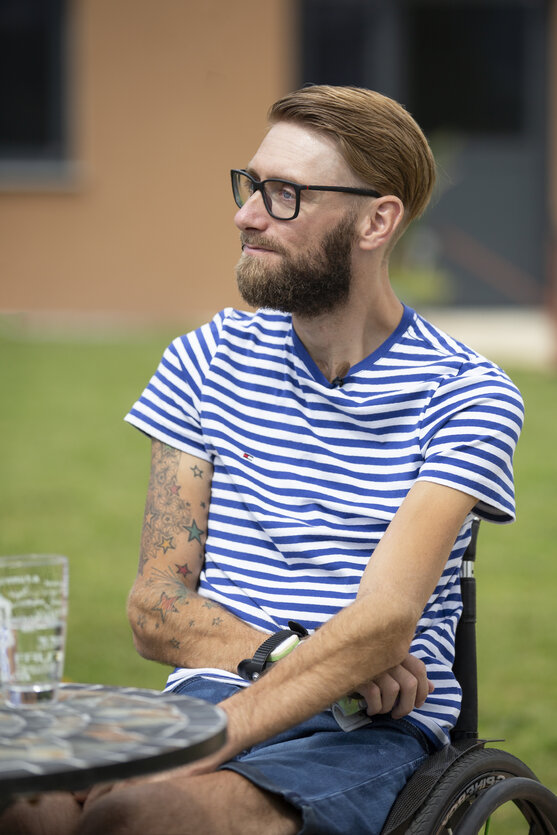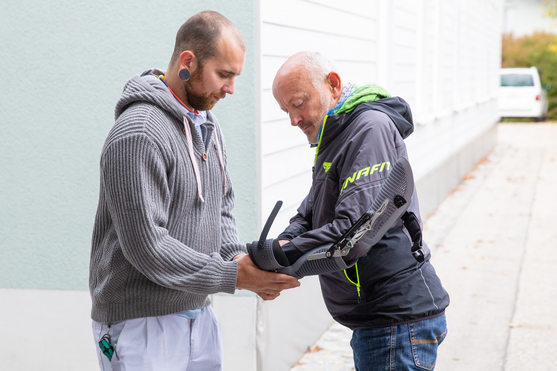Is your knee musculature paralyzed? Then the computer-controlled C-Brace® leg orthosis gives you a completely new freedom of movement!
Martin has been paralyzed from his chest down since his motorcycle accident. We build him a tool for fly fishing. He travels all over the world.
Make an appointment over the phone or send us a message!
Inability to move
Paralysis and its causes
Paralysis refers to the partial or complete malfunction of individual parts of the body (e.g. arm, leg) or entire body sections (e.g. a side of the body). From a neurological point of view, this is a disorder of the nerves or the transition from the nerves to the muscles. A distinction is made between incomplete paralysis (paresis), which means partial loss of force, and complete paralysis (plegia).
Paralysis can have various causes. It is often caused by diseases or damage to the brain, spine, neural pathways or muscles. Infections and various internal diseases can also cause paralysis.
Common causes of paralysis include:
- Spinal cord injuries
- Spina bifida
- Herniated disc
- Multiple sclerosis (MS)
- Stroke
- Bleeding
- Polyneuropathias (illnesses of multiple nerves)
- Pediatric paralysis
- Poliomyelitis
- Brain inflammation (meningitis)
- Amyotrophic lateral sclerosis (ALS)

The causes can be divided into three groups:
The cause of peripheral paralysis is damage to the nerves or to the connections between the nerve and muscle, e.g. crushing of the nerves (e.g. due to an accident or slipped disc).
The cause of central paralysis is an injury to the brain or spinal cord, e.g. in the event of a stroke or brain bleeding.
The cause of paralysis occurs in the muscles themselves, e.g. inflammatory muscles or muscle diseases.
Hand orthoses make it possible!
Riding a handbike despite paraplegia
Colorful tattoos, bright blue eyes and almost always a smile on his face – today we pay a visit to Daniel in Upper Austria. At first glance, the 32-year-old doesn't even notice his difficult fate: Daniel was a paramedic and was hit by a passing car as he was attending an accident scence. Since then, he has been paralyzed from the sixth cervical vertebra downwards. Much of what he took for granted up until his accident suddenly became distant memories. However, this does not prevent the young athlete from realizing his dreams...

Let yourself be inspired! We accompany many interesting patients during their Pohlig appointment and give you personal insights.

For those who want to delve even deeper into the matter, we have a suitable video for almost every supply area.

Take a look behind the scenes at Pohlig and find out about diagnoses and our innovative aid solutions!
All-round care!
We have the solution
We offer you a wide range of orthotic treatment options. From hand orthoses and functional aids to leg orthoses and corsets – our goal is to find a care solution that is optimally tailored to your needs.
Our aids are individual building blocks of the medical and therapeutic treatment concept. Amazing results for paralyzed patients can be achieved in combination with physiotherapy and rehabilitation aids.


Arm paralysis caused by injured nerves
Obstetric brachial plexus palsy (OBPP)
Basically, the arm is supplied by the nerve plexus "plexus brachialis". The nerves run from the cervical spine through the shoulder to the upper and lower arm and are responsible for allowing the arm to move and feel. After an obstetric brachial plexus palsy (also Erb's or Klumpke's palsy, brachial plexus injury), these nerves are injured, which in turn affects the musculature and sense of touch.
Paralysed arm
Roland rides his bike again
Six years ago, Roland and his wife had a motorcycle accident. Since then, Roland can no longer move his left arm. Because he didn't want to give up cycling despite the paralysis, he looked for a solution. Everyone told him that it was impossible to ride a bike with a paralysed arm. In Ruhpolding, he finally found a bike store that converted Roland's e-bike so that he could brake and shift gears with his right hand.
Then we came into play: we made Roland a 3D printed orthosis that attaches to the handlebars. Its integrated gas pressure spring acts as a damper, optimally transferring the weight distribution of the upper body to the handlebars. Roland is thrilled - and we are by his strong will and optimism!




